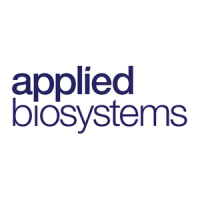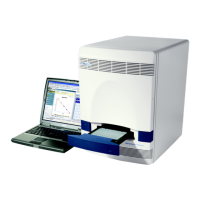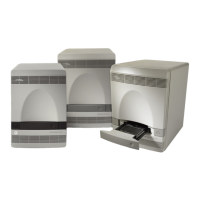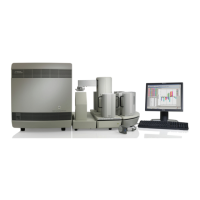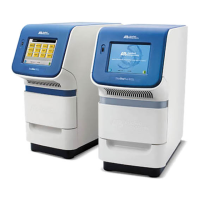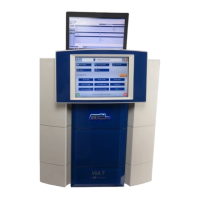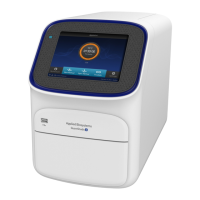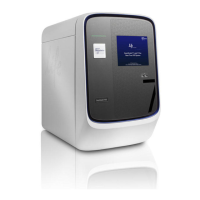What to do if Applied Biosystems 2720 shows 'T temperature out of range m' error?
- JJoann RiveraSep 10, 2025
If your Applied Biosystems Laboratory Equipment displays a 'T temperature out of range m' error, check the input value and try again.
What to do if Applied Biosystems 2720 shows 'T temperature out of range m' error?
If your Applied Biosystems Laboratory Equipment displays a 'T temperature out of range m' error, check the input value and try again.
What to do if Applied Biosystems Laboratory Equipment shows 'User name already defined'?
If your Applied Biosystems Laboratory Equipment displays a 'User name already defined' message, ensure that you are not duplicating user names.
What does 'Remove infinity hold first' mean on Applied Biosystems 2720 Laboratory Equipment?
The 'Remove infinity hold first' message on your Applied Biosystems Laboratory Equipment indicates that you need to add segments prior to the post-PCR infinity hold.
What to do if the whirring fan does not sound on Applied Biosystems 2720 Laboratory Equipment?
If the whirring fan sound is absent on your Applied Biosystems Laboratory Equipment, verify that the power switch is ON, the power cord is connected, and check the fuses.
Why doesn't the displayed temperature match the specified temperature on my Applied Biosystems Laboratory Equipment?
The instrument may require calibration.
How to fix user input errors on Applied Biosystems 2720 Laboratory Equipment?
To resolve user input errors on your Applied Biosystems Laboratory Equipment, try the following: Re-enter data within the field's specifications, use finite values for cycle segments, include seconds when entering the time, enter the correct PIN#, and do not assign more than six hold or cycle parameters to a method. If the error is related to TmCalc data, enter a value in the P1 and P2 fields. If you are exceeding the limit of 137 methods or the storage space, delete or store rarely used methods elsewhere. Also, assign finite time segments to holds within a method, delete or transfer the associated methods before deleting a user name, enter the user name to which the desired method is assigned, specify the method name and choose a user to store a method, review and correct the method to in...
| Type | Thermal Cycler |
|---|---|
| Temperature Accuracy | ±0.25°C |
| Temperature Uniformity | ±0.5°C |
| Display | LCD |
| Power | 100-240V |
Explains how to use the manual, including text conventions and user attention words.
Provides details on related documentation and how to contact the company.
Guides users on how to find support services and contact information.
Defines safety alert words (IMPORTANT, CAUTION, WARNING, DANGER) and symbols.
Describes electrical and safety symbols used on Applied Biosystems instruments.
Lists CAUTION, WARNING, and DANGER statements found on instrument labels.
Shows the location of hazard and warning labels on the instrument's rear.
Covers safety precautions for moving, lifting, and operating the instrument.
Details hazards and precautions related to handling chemicals.
Provides guidelines for safely handling and disposing of chemical waste.
Outlines safety measures related to grounding, fuses, power, and overvoltage.
Specifies conditions for safe operation and storage of the instrument.
Warns about hazards from moving parts and hot surfaces.
Lists compliance with various safety and EMC standards.
Introduces the chapter and its topics.
Describes the instrument's purpose, features, and comparison to previous models.
Details the instrument's control panel layout and functions.
Summarizes the main functions accessible from the Main Menu.
Explains the graphical representation of a method on the Create/Edit screen.
Introduces the chapter and its basic procedures.
Provides step-by-step instructions to turn on the instrument.
Guides users on how to create a user profile for method management.
Explains how to create and save a new PCR method.
Details the process of modifying an existing stored method.
Describes how to initiate and then abort a PCR run.
Introduces additional system features beyond basic operation.
Explains how to run samples, use disposables, and manage runs.
Describes the different types of MicroAmp disposables available.
Provides procedures for loading samples into tubes or plates.
Details the steps to start a PCR run from the Main Menu.
Explains how to pause, resume, or completely stop a run.
Guides on how to access and interpret run history data.
Describes what happens when a run finishes or is aborted.
Covers creating, editing, and managing methods and user names.
Details procedures for managing user accounts on the instrument.
Explains how to create and store a new PCR method.
Describes how to edit methods with advanced options like holds and cycles.
Explains how to select, sort, search, print, and delete methods.
Introduces functions available from the Utilities menu.
Explains how to set instrument parameters like time, date, and printer.
Provides instructions for updating the instrument's firmware.
Details how to connect an optional printer to the instrument.
Guides on using the Tm Calculator for primer analysis.
Explains how to perform display and keypad diagnostic tests.
Describes the test for verifying instrument temperature calibration.
Explains the test for sample block temperature uniformity.
Guides on performing Rate and Cycle tests for system performance.
Introduces procedures for maintaining the thermal cycler.
Provides instructions for cleaning the instrument's sample wells and cover.
Details the steps for safely replacing instrument fuses.
Explains how to diagnose and solve instrument problems.
Describes the instrument's behavior during power outages.
Lists error messages, their causes, and recommended actions.
Provides a table of common problems, causes, and remedies.
Introduces the appendix detailing instrument specifications.
Lists dimensions, weight, power requirements, and configurations.
Details specifications for the display screen and control panel keys.
Provides information on sample temperature range and calibration.
Lists serial interface board specifications for printer connectivity.
Introduces the appendix describing precoded methods.
Lists and briefly describes the five precoded methods available.
Introduces flowcharts for understanding procedures.
Provides a flowchart for the instrument's Run function.
Shows a flowchart for stopping or ending a run.
Provides a flowchart for creating and editing methods.
Displays a flowchart for managing user accounts.
Presents a flowchart for accessing instrument utilities.
Shows a flowchart for running instrument diagnostics.
Provides a flowchart for firmware upgrades.
Introduces information on warranty, configuration, and claims.
Discusses recommended computer configurations for the instrument.
Details the warranty terms for instruments and accessories.
Outlines procedures for handling product damage, claims, and returns.
